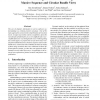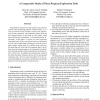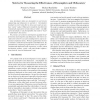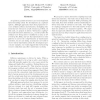IWPC
2007
IEEE
14 years 6 months ago
2007
IEEE
The use of dynamic information to aid in software understanding is a common practice nowadays. One of the many approaches concerns the comprehension of execution traces. A major i...
IWPC
2007
IEEE
14 years 6 months ago
2007
IEEE
Eye-tracking equipment is used to assess how well a subject comprehends UML class diagrams. The results of a study are presented in which eye movements are captured in a non-obtru...
IWPC
2007
IEEE
14 years 6 months ago
2007
IEEE
A workflow is a computerized specification of a business process. A workflow describes how tasks are executed and ordered following business policies. E-commerce systems implement...
IWPC
2007
IEEE
14 years 6 months ago
2007
IEEE
A commonly used strategy to address the scalability challenge in object-oriented reverse engineering is to synthesize coarse-grained representations, such as package diagrams. How...
IWPC
2007
IEEE
14 years 6 months ago
2007
IEEE
Programmers need tools to help explore large software systems when performing software evolution tasks. A variety of tools have been created to improve the effectiveness of such e...
IWPC
2007
IEEE
14 years 6 months ago
2007
IEEE
The field of program comprehension is characterized by both the continuing development of new tools and techniques and the adaptation of existing techniques to address program co...
IWPC
2007
IEEE
14 years 6 months ago
2007
IEEE
Java developers often use decompilers to aid reverse engineering and obfuscators to prevent it. Decompilers translate low-level class files to Java source and can produce “good...
IWPC
2007
IEEE
14 years 6 months ago
2007
IEEE
A repository of task structures can reveal important latent knowledge about the development of a software system. Although approaches have been proposed to recover artifacts withi...
IWPC
2007
IEEE
14 years 6 months ago
2007
IEEE
IWPC
2007
IEEE
14 years 6 months ago
2007
IEEE
An approach to recover/discover traceability links between software artifacts via the examination of a software system’s version history is presented. A heuristic-based approach...




